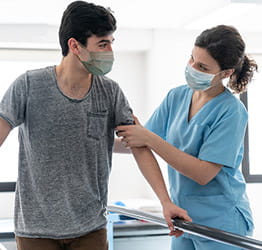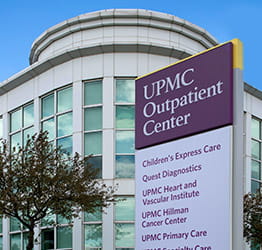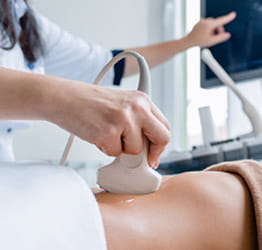What Is Mechanical Thrombectomy Using a Stent Retriever?
Mechanical thrombectomy using a stent retriever — also known as endovascular thrombectomy (EVT) — is a minimally invasive procedure to treat ischemic stroke by removing a blood clot from a blood vessel in the brain.
The procedure involves using a small, thin tube called a catheter that your doctor guides to the site of your blood clot. After the catheter is in place, your doctor will use a special device called a stent retriever to pull out the clot or use other devices to break up and suction out the clot.
EVT procedures can also be used to remove blood clots in other parts of your body, such as your heart.
Types of EVT
Types of EVT include:
- Aspiration thrombectomy — Uses a device to suction the clot out of your blood vessel.
- Stent retriever thrombectomy — Uses a small, tube-shaped device to surround and pull out the clot, removing it from your blood vessel.
Your doctor may use other techniques — including ultrasound, laser, or radiofrequency energy, or other specialized devices — to break up the blood clot and remove it from your blood vessel.
Conditions we treat with EVT
EVT treats blockages caused by blood clots in blood vessels throughout the body, including:
Why Would I Need EVT?
You may need EVT if you have been diagnosed with an ischemic stroke, which happens when a blood clot blocks blood flow to your brain. Your doctor may recommend EVT to treat other conditions that occur when a blood clot blocks blood flow to another part of your body.
Who’s a candidate for EVT?
You may be a candidate for EVT if you have an ischemic stroke or another condition caused by a blockage due to a blood clot that can’t be effectively treated with thrombolytic (clot-busting) medications.
Although EVT is an effective treatment for some people, you may not be a candidate EVT if:
- You have a preexisting blood disorder.
- You have an intracranial hemorrhage (bleeding in your brain).
- You have high blood pressure.
- Your blood clot can be treated with medication.
- Your blood clot is in a hard-to-reach location.
- Your blood clot is in a small blood vessel.
- You’ve had your blood clot for more than 30 days.
Alternatives to mechanical thrombectomy
- Catheter-directed thrombolysis — Delivers clot-busting medication directly to the site of your blood clot using a catheter.
- Intravenous thrombolysis — Delivers clot-busting medication through an intravenous (IV) line, so it travels through your bloodstream to dissolve the clot.
- Surgical (open) thrombectomy — Involves making an incision in your skull and removing your blood clot.
What Are the Risks and Complications of EVT?
Although mechanical thrombectomy is a minimally invasive procedure, it does come with some risks, including:
- Bleeding.
- Blood vessel damage.
- Bruising.
- Infection.
- Narrowing of your blood vessel.
- Pulmonary embolism.
- Problems with anesthesia.
What Should I Expect From EVT?
Before: How to prepare for EVT
If you are diagnosed with an ischemic stroke or another life-threatening medical condition, you may not be able to prepare for an emergency EVT. Before performing your procedure, your doctor may order tests including:
- Blood tests — Your doctor may order blood work to make sure you are healthy enough for the medication and check for signs of illness or infection.
- CT or MR angiogram — Also known as arteriography or an arteriogram, this test uses x-rays or magnets and a special contrast dye to look for problems with the blood vessels in your brain.
- CT scan — A computed tomography (CT) scan can diagnose stroke or another condition caused by a blood clot.
- Doppler ultrasound — A noninvasive test that uses ultrasound waves to measure blood flow through your arteries and veins.
- Echocardiogram (Echo) — A noninvasive test that uses sound waves to create images of your heart.
- Electrocardiogram (ECG or EKG) — This test records the electrical activity of your heart and can help diagnose abnormal heart rhythms that may cause blood clots.
- MRI — A diagnostic procedure that combines large magnets, radio frequencies, and a computer to produce detailed images of your brain.
Your doctor may also give you a clot-busting medication through an IV line. The medication will travel through your bloodstream to your entire body.
How long does EVT take?
EVT procedures typically take between an hour and several hours, depending on the severity and location of your blood clot.
During your EVT
Before your procedure, you will receive an IV and either general anesthesia to put you to sleep or sedation to help you relax.
During the procedure, your doctor will:
- Make a small incision, commonly in your groin or wrist.
- Insert a thin, flexible tube called a catheter.
- Guide it through your blood vessels to the site of your blood clot using x-ray imaging guidance.
- Insert a special wire mesh device called a stent retriever into the catheter. The stent retriever reaches past the clot and temporarily blocks the artery, so blood can’t flow.
- Retrieve the stent by pulling it backward to help remove the clot. Your doctor may also use other devices to suction out or break up the blood clot.
- If necessary, inject a clot-busting medication at the site of your blood clot to ensure it is completely dissolved or removed.
- Remove the device and catheter and close your incision.
Recovery after mechanical thrombectomy
After your procedure, you will need to stay in the hospital for a few days. During your stay, your care team will watch closely for signs of bleeding and other complications. You may also have imaging tests to determine why you formed a blood clot.
When to call your doctor about complications
You should contact your doctor if you have complications, including:
- Balance problems.
- Bleeding.
- Chest pain.
- Confusion.
- Disorientation.
- Dizziness.
- Drainage from your incision site.
- Fever.
- Pain, swelling, or numbness in your arms or legs.
- Shortness of breath.
What’s the prognosis after EVT?
When used in combination with IV thrombolytics and other medical treatments, research shows that EVT improves stroke outcomes by reducing the risk of disability and death.
Your prognosis after EVT depends on several factors, including the severity of your condition and how quickly you receive medical treatment. In some cases, blood clots in your brain or other parts of your body can be deadly.
Some people who survive after having a blood clot may have no long-term disability, but others may have permanent disability ranging from mild to severe.
What’s the success rate of EVT?
EVT effectively removes blood clots in about 80% of people. However, in some people, doctors can’t remove the blood clot entirely, or another blood clot develops in the future. Your doctor will monitor your condition and let you know if you need follow-up care.
Why Choose UPMC for EVT?
When you choose UPMC for EVT care, you will receive:
- Access to world-class neuroscience expertise — UPMC is among the world’s best multidisciplinary stroke centers. When surgery is necessary, our team is experienced in advanced treatments, including traditional and investigational approaches that are not widely available.
- A full range of treatment options — We offer minimally invasive care as well as traditional open surgical procedures, allowing us to effectively treat all types of complex stroke conditions, reducing your risk of complications.
- Multidisciplinary care — We partner with neurologists, rehabilitation specialists, and other medical experts to provide complete care that optimizes your recovery and quality of life.
By UPMC Editorial Staff. Last reviewed on 2025-10-23.
















